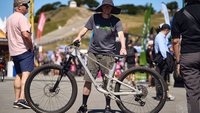Posted by: cerealkilla_
Posted by: norona
Posted by: Ouch
I think it's critical that a decision be made either way, sooner than later. I don't think it's fair to everyone involved to let this linger on.
Already been made class 1 e-mtb are classified as mtb. 🤙
Not entirely correct. Class 1 e-mtb are classified as Class 1 e-mtb, and are thus prohibited from a limited set of riding areas such as Lord of the Squirrels, and certain private land trails managed by the Kootenay Columbia Trail Society/ KCTS (due to issues with insurance liabilities). There may be other areas added to this list as land-owners, insurance bodies, and wildlife managers take stock of emtbs and what they entail. Important to consider that it doesn't matter if these groups are correct in any assumptions they make regarding emtb, only that they have the power to influence restrictions. So I would think how you present yourself matters more than ever.
The recent decision on provincial recreation trails is a progression and really did help clarify some important issues, but there is still lots to figure out.....especially for clubs that have insurance and liability at stake. Of course, I would expect that people interested in promotion of emtbs would be very active in helping sort these things out.
As for riding UP tech trails, that sound great....assuming they are uphill tech trails. Of course, riding up downhill trails (designated as downhill primary on Section 56 permits) seems like a questionable idea, given the potential for conflict or collision with downhill riders. It is one thing for a downhill rider to see and avoid a hiker, but quite another to prepare for and avoid riders coming uphill toward them. Who gets the right of way?...the uphill emtb rider with his or her thumb on the boost button, or the downhill rider committed to their line? Surely ensuring safety and harmonious trail interactions takes precedence over espousing the virtues of a technology without consideration of the implications of its use. This (uphill downhill on the same trail) is an example. I have heard repeatedly that "emtbs are mtbs" yet at the same time they can be used in very different ways, have very different capabilities, and are assigned a distinct classification by the province that "acoustic" mtbs do not share. There is an established flow of traffic that has thus far served our trails and users well, and if that is to be upended by introduction of a new classification of vehicle, it should be discussed.
I will note that neither of the mentioned points aim to belittle emtbs or those that ride them, and are not calling for restrictions. Instead, they are simply what myself, and apparently some others see as legitimate concerns that should be addressed in order to maintain harmonious trails and access. I am really interested in hearing some good ideas and input on these, and less interested in more marketing of all that is great and rad.
I would think that the most vocal of the emtb promoters would have some thoughtful ideas for these matters, and would want to avoid stooping to engage others in name-calling. I mean, it is only going to be harder to win over either customers or allies by dismissing concerns as "the same fruit loops on here wasting time at work making up the dumbest shit imaginable" while not contributing to a thoughtful conversation about legitimate concerns. So I pose it to you Norona, three questions:
1) How do you think we should we manage the intersection of uphill emtb traffic and downhill (emtb and mtb) traffic on downhill primary trails. By this, I mean trails that ordinarily, the vast majority of people would not ride up, but which become suddenly climbable with the addition of a battery and motor?
2) Are you, or any sellers or makers of emtbs making progress with or contributing to the discussions with the insurance companies and private landowners who have concerns about emtbs? Clearly we don't want such liabilities hanging over the heads of our clubs or the security of our trail access, and clarification would likely lead to more successful integration and ensured access. For example, KCTS is in a real pickle with the recent provincial decision, and want to take steps to integrate ebikes for all their positives, but remain hamstrung by insurance and liability impasses. Do you have thoughts on this?
3) What is your analysis of the recent provincial decision on recreation trails? Specifically, do you have any thoughts on challenges associated with enforcement of appropriate types of equipment and trail access (pg 10 on the policy)... What do you think needs to happen (and what needs to be avoided) during the stated "test period" of 2018 to 2021 (pg 11) for this policy to roll into an enduring state of trail access that works for everyone?
Personally, I like the policy, but I note it remains wide open for significant policy adjustment depending on how things roll for the next few years. I also think it misses a few things (such as point #1).
Thanks for the reply and explanation, you make some valid points/questions as well.
I'm trying to keep an open mind, but when I see very healthy people zip by me on their ebikes, the first thought that comes to my mind, is we live in a society that wants instant gratification without having to work for it.......







